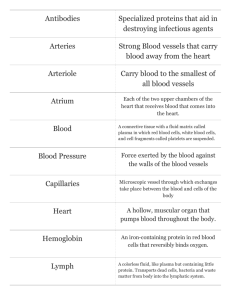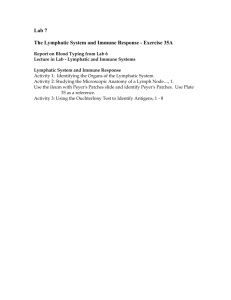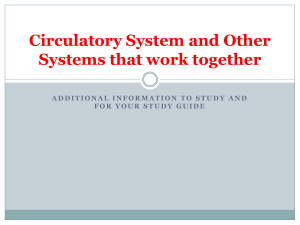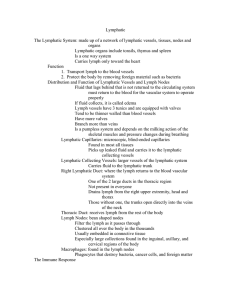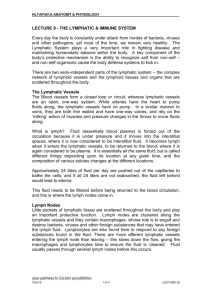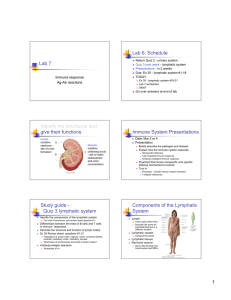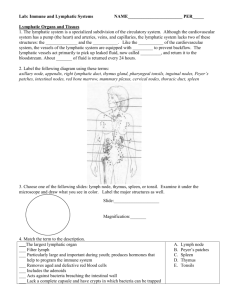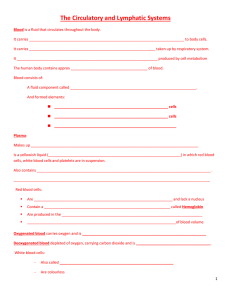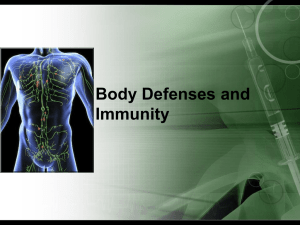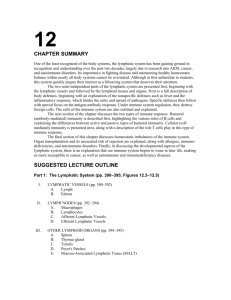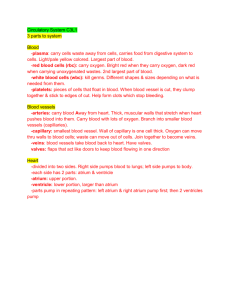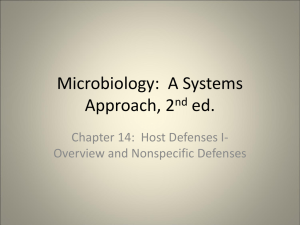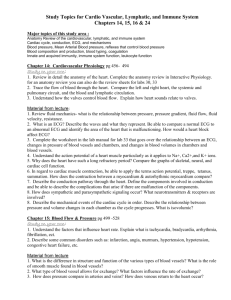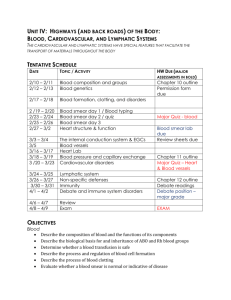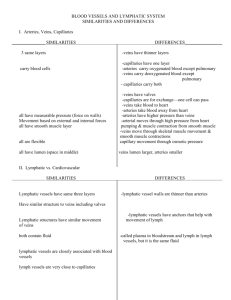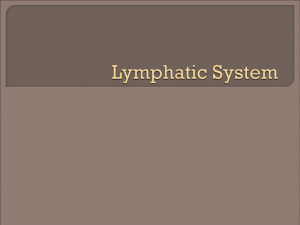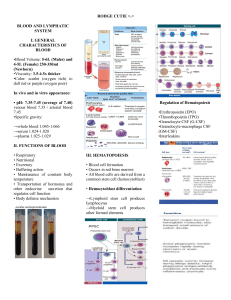The Cardiovascular System: The Blood
advertisement
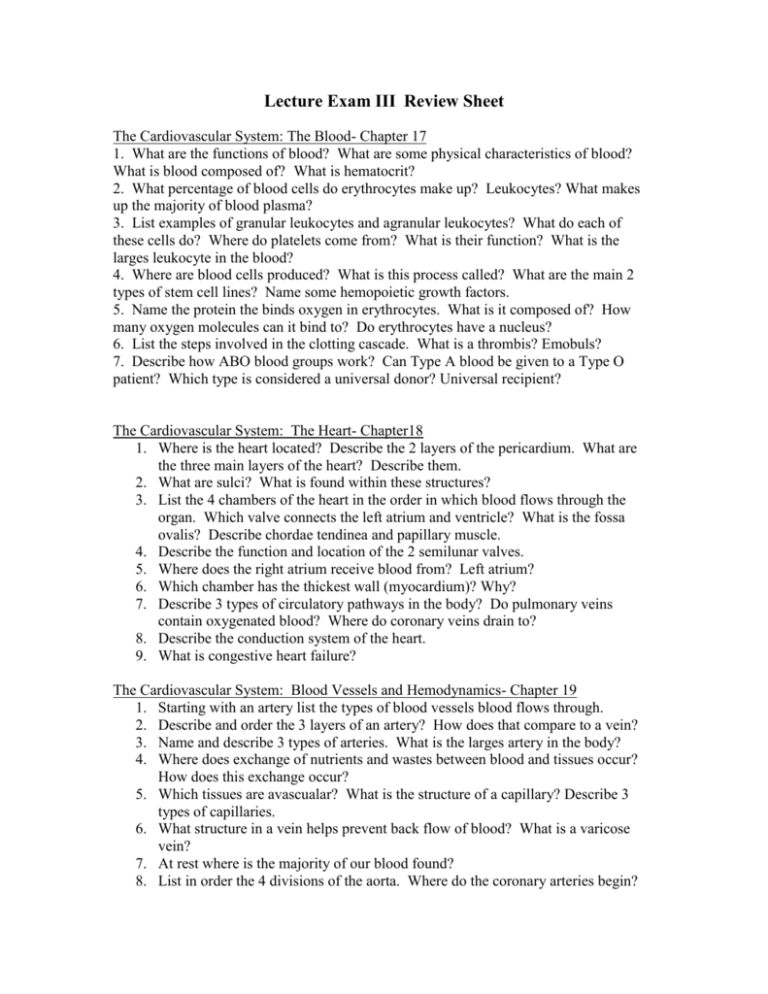
Lecture Exam III Review Sheet The Cardiovascular System: The Blood- Chapter 17 1. What are the functions of blood? What are some physical characteristics of blood? What is blood composed of? What is hematocrit? 2. What percentage of blood cells do erythrocytes make up? Leukocytes? What makes up the majority of blood plasma? 3. List examples of granular leukocytes and agranular leukocytes? What do each of these cells do? Where do platelets come from? What is their function? What is the larges leukocyte in the blood? 4. Where are blood cells produced? What is this process called? What are the main 2 types of stem cell lines? Name some hemopoietic growth factors. 5. Name the protein the binds oxygen in erythrocytes. What is it composed of? How many oxygen molecules can it bind to? Do erythrocytes have a nucleus? 6. List the steps involved in the clotting cascade. What is a thrombis? Emobuls? 7. Describe how ABO blood groups work? Can Type A blood be given to a Type O patient? Which type is considered a universal donor? Universal recipient? The Cardiovascular System: The Heart- Chapter18 1. Where is the heart located? Describe the 2 layers of the pericardium. What are the three main layers of the heart? Describe them. 2. What are sulci? What is found within these structures? 3. List the 4 chambers of the heart in the order in which blood flows through the organ. Which valve connects the left atrium and ventricle? What is the fossa ovalis? Describe chordae tendinea and papillary muscle. 4. Describe the function and location of the 2 semilunar valves. 5. Where does the right atrium receive blood from? Left atrium? 6. Which chamber has the thickest wall (myocardium)? Why? 7. Describe 3 types of circulatory pathways in the body? Do pulmonary veins contain oxygenated blood? Where do coronary veins drain to? 8. Describe the conduction system of the heart. 9. What is congestive heart failure? The Cardiovascular System: Blood Vessels and Hemodynamics- Chapter 19 1. Starting with an artery list the types of blood vessels blood flows through. 2. Describe and order the 3 layers of an artery? How does that compare to a vein? 3. Name and describe 3 types of arteries. What is the larges artery in the body? 4. Where does exchange of nutrients and wastes between blood and tissues occur? How does this exchange occur? 5. Which tissues are avascualar? What is the structure of a capillary? Describe 3 types of capillaries. 6. What structure in a vein helps prevent back flow of blood? What is a varicose vein? 7. At rest where is the majority of our blood found? 8. List in order the 4 divisions of the aorta. Where do the coronary arteries begin? The Lymphatic and Immune Systems- Chapter 21 1. List the organs and tissues of the lymphatic system. What are their functions? 2. What is the fluid of the lymphatic system? What is the function of this system? 3. Describe lymphatic vessels and circulation. Do lymph vessels more resemble veins or arteries? Where do lymph vessels finally empty? Where do you not find lymph vessels? 4. Contrast Primary and Secondary lymphatic organs/tissues. What is the specific function of each organ/tissue? 5. Describe the anatomy of the spleen. What are the functions of the pulp? 6. Contrast nonspecific and specific immunity. List are examples of each. What are the steps involved in phagocytosis? 7. Where do B and T cells mature? 8. What is an antigen? Examples. What is an epitope? How many epitopes can the immune system respond to? How is this possible? 9. Contrast MHC I and MHC II molecules? What cells have each? What exactly do B cells and T cells recognize? 10. How does the processing of a exogenous antigen differ from that of a endogenous antigen? 11. What is the difference between cell-mediated and antibody-mediated immunity? What immune cells are involved in each? 12. How are T cells and B cells activated? What happens after activation? What is costimulation? 13. List and describe the different types of T and B cells. 14. How are foreign invaders eliminated by the immune system? 15. Describe the structure of an antibody. How do they work? 16. Contrast primary immune responses and secondary immune responses. The Respiratory System- Chapter 22 1. List the structures involved in the respiratory system. What are their functions? 2. What type of epithelium lines the nasal cavity? Name the parts of the pharynx. 3. What cartilages make up the larynx? Do females have an Adam’s apple? 4. Contrast true and false vocal cords. How does the pitch of the voice change? Contrast male and female vocal cords. 5. List the branches of the bronchial tree. Describe the changes in the epithelial lining of the bronchial tree as you move deeper into the lungs. 6. What is pleura? How many lobes does the right lung have? left lobe? 7. What cells are found in the alveoli? What are their functions? List the four layers gas must move across in order to enter the blood. 8. What is Boyle’s law? How does it relate to breathing? Describe what happens to the chest and muscles during inspiration and expiration. 9. What is alveolar surface tension? How do cells reduce it? 10. Define lung volume and capacity definitions. 11. Describe Dalton’s law. How does it relate to external and internal respiration. Describe gas flow in these processes. How does acidity, pCO2, temperature relate to oxygen binding of hemoglobin. List the 3 ways CO2 is transported in the blood.

